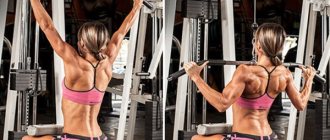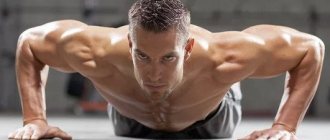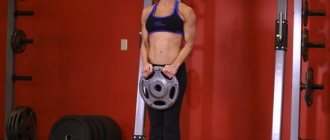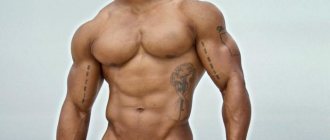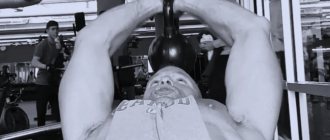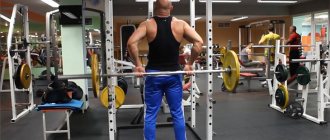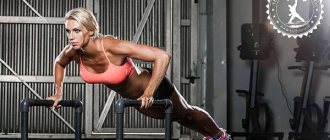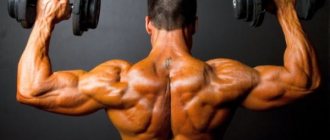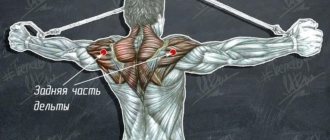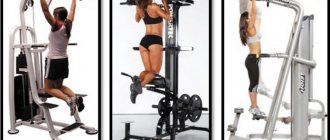Why don't my shoulders grow? 5 reasons
The deltoids have a sacred meaning for any athlete, along with the pecs and biceps: of course, because these most fragile shoulders bear one of the most serious missions - to form that very V-shaped figure that will tell everyone for you: you are firmly friends with fitness. However, it often happens that friendship with bodybuilding does not bring results, and deltoids do not want to increase in size. Why don't my shoulders grow? Today we will look at 5 reasons why deltoids refuse to increase in size despite your diligence in the gym.
Weak development of deltoids
Deltas do not like the same type of exercises and insufficient attention during training. So if you do overhead presses on your shoulders, and only overhead presses, be prepared for the fact that your deltoids will not grow the way you want them to. Remember: the deltoid muscle consists of three bundles , and most exercises for the anterior and middle bundles almost do not include the back one and vice versa. It is for this reason that the training should be balanced: include in the training the barbell overhead press, military press, barbell row to the chin and swings forward to the sides and back. Combine these exercises, combine them, master the technique of drop sets and pumping. The main thing is, if your deltoids are not growing, do not limit yourself to one or two exercises, but make your shoulder training moderately long and varied.
How to pump up your rear delts
Goal: building up the posterior deltoid muscles
The posterior deltoid muscles often lag not only in beginners, but also in advanced bodybuilders. Simply put, they don't get as much stimulation as the front and middle deltoids, which are involved in chest exercises and shoulder presses.
To develop your rear delts, perform this routine for 4-8 weeks, or alternate it with a more balanced shoulder workout.
A set of exercises for the rear deltoids
- Overhead Press – 4 sets of 8-10 reps (2 minutes rest)
- Bent-over dumbbell raises - 4 sets of 8 reps (60-90 seconds rest)
- Crossover raises - 3 sets of 10 reps (60-90 seconds rest)
- Butterfly raises - 3 sets of 10-12 reps (60-90 seconds rest)
Emphasis on the positive phase
Why don't your shoulders grow , even if you spend enough time on them in the gym and combine different exercises? The answer may be simple - often even professional athletes emphasize the positive phase of the barbell or dumbbell movement: they slowly lift the weight and then quickly lower it. With the shoulders, as with many other muscle groups, you need to do exactly the opposite: lifting the weight should be quick and clear, and the negative phrase should be measured . In it, you must make a muscular effort to resist the weight and slowly lower the weight. Try to place emphasis in the exercises in a new way, and you will definitely see a completely different result!
The load is taken by the trapezoids
For all deltoids exercises, the shoulders should be lowered down and not lifted up by the trapezius.
A fairly common mistake made by beginners is cheating during shoulder exercises, when the trapezius involuntarily rises to the ears and helps pull the weight. Needless to say, with this balance of power, your deltoids receive far from the full portion of the load. That is why, in all exercises for the deltoids, the shoulders should be lowered down and not raised up by the trapezius. Monitor this especially carefully when performing dumbbell swings and crossovers.
Weight does not increase
The main condition for permanent muscle hypertrophy is increasing working weight . So if your weight doesn’t change and your deltoids don’t grow, there’s a reason to move on. at least 2.5 kg more weight in your next workout . Yes, this may have a negative impact on the number of repetitions, but this is not a problem. Do the bench press as many times as you can, then the next workout increase the number of reps by 1, then by 2, and so on. Little by little you will come to the number of repetitions you are accustomed to, but with more weight, and your deltoids will surprise you by adding in volume.
Insufficient number of repetitions in the set
Unlike most other muscle groups, shoulders love high-repetition sets.
If you are successfully following all the previous recommendations, but you still have the question “why your shoulders don’t grow,” there is one more important detail. Not doing enough reps per set can also cause your shoulders to be underloaded and not grow. Here it must be said that, unlike most other muscle groups, shoulders love high-repetition sets. So if you're limiting yourself to 6-9 reps, that might be good for the chest, but it's definitely not good enough for the shoulders. Increase the number of repetitions to 12-15 , and the effectiveness of your training will increase by an order of magnitude.
By the way, to increase the number of repetitions, you can use the drop set method and lose some of the weight at the moment of failure. Just remember - it’s better not to abuse this technique and use drop sets no more than once a month.
Now you know why your shoulders don’t grow and how to avoid mistakes and stagnation in training. Follow our five tips, and you will definitely see progress, and your deltoids are guaranteed to grow. But remember: one of the main tips when training deltoids is not to get hung up on one technique , alternate loads and include new exercises for 2-3 months. This is the only way your muscles will not get used to the existing loads and will be able to grow confidently.
Problem: You're the Last to Focus on Your Deltoids
Concentrating all your attention on the muscles of the chest, back and legs is very good. After all, these are the largest muscle groups in the body that produce the most mass and strength. But let's be honest, if you completely neglect your deltoids, you won't be able to build really big, muscular shoulders.
How to fix it: Make deltoid training a priority. Do you want a serious approach? Set aside one day just for them or put them first in arm training, for example. Don't think of your shoulders as small, weak muscles that don't deserve much attention.
2. Problem: You're using too much weight with poor conditioning Train each head of the deltoid (front, side, back) as a separate muscle. While training your shoulders, focus on your arm work and thoroughly explore your potential for better and more effective exercises.
Admit it, are you turning your shoulder press into an incline press and only using half the range of motion? Conclusion: You are using too much weight!
What about dumbbell lateral raises? Are you twisting, swaying and losing your rhythm? And how does this work for you?
How to fix it: The best way is to cut your current weight by almost half, but at the same time achieve ideal exercise performance by doing them regularly. Your job is to practice the movements, bring them to automaticity, so that your shoulders “remember” the algorithm, the correct contraction and control. This will increase strength and protect your deltoids from damage. When you focus on practicing the movements, you will see improvements in muscle mass and real, functional strength.
The correct technique and types of exercises to pump up the rear delts
Unlike the front deltas, the main purpose of the rear ones is to pull and pull the limbs back, so they are trained with the help of rows and swings. Of these two types of exercises, I recommend doing deadlifts, since deadlifts are more basic exercises that work several joints at once. This provides more exercise, a greater release of hormones and, as a result, leads to better growth. In addition, working with basic exercises allows you to use the principle of progression of loads, you will be able to work with large weights.
Expert opinion
Dumbbell swings and flyes are a good isolating exercise that is well suited for spot work, so I advise beginners not to do swings for the first six months to a year of training. I am not going to consider the method of training on simulators at all, since working with free weights is much more effective.
So, let's move on to the exercises:
- Lee Haney deadlift. Invented by an 8-time Mr. Olympia title winner, this deadlift is the best basic exercise for the middle and rear deltoids. We take a position with our back to the bar mounted on a rack or in a power rack. Straighten your shoulders, feet shoulder-width apart. We take the barbell with a reverse grip, straighten our arms so that the barbell is just below the butt and begin work. We lift the barbell with the help of deltas and trapezius to approximately the level of the lower back, hold for a second at the end point, and then lower the barbell. The exercise technique is quite complex, so I advise you to familiarize yourself with the attached video.
- Bent-over barbell row. Performed in the same way as the variation for the back. The only difference is the angle of inclination: it is significantly lower. We approach the bar (this time from the front), take a position: feet shoulder-width apart, back straight. We lean forward with the barbell at an angle of 90 degrees, take the barbell with a wide grip and pull it with the help of the rear deltoids to the chest. It is important to maintain a 90 degree angle between your arm and shoulder. Gives a good load on the middle deltoids as well.
- Bent-over dumbbell raises. We take the starting position and bend down, take dumbbells in our hands and raise them to the sides and slightly forward. We hold the dumbbells with a horizontal grip so that the trapezoid does not steal the load. Many people do this exercise by resting their head on a bench. During work, we do not allow dead spots - the shoulders should be in motion throughout the entire exercise. Can be performed either standing or lying face down on an inclined bench.
I will separately highlight exercises in the crossover:
- Bent over swings. The essence is the same as with dumbbells, the elbows should be turned towards the ceiling, we try to look at the floor.
- Swing on the top block. We take the handles of the crossover in our hands so that the cables intersect. We get into the starting position, feet shoulder-width apart. The elbows are in a fixed position, we pull back with the help of the rear deltoids, we try to focus and feel the work of the muscles. It is important not to spread your arms completely; they should be slightly bent and fixed.
Problem: You've overtrained your anterior deltoid.
Next time you're at the gym and someone is training your deltoids, take a closer look. Are they performing dumbbell presses, machine presses, and dumbbell front or side swings? In reality, only the mass of the front head is working. Not only is this an overshoot, but it also has a negative impact on other exercises such as the bench press.
How to fix it: Reduce your shoulder training to one exercise for all three heads of the deltoid muscle. Let it be a bench press and, if this is not enough, lifting dumbbells in front of you. This will protect you from overtraining your anterior deltoid so you can focus more on future shoulder training.
Problem: You're contracting your deltoids incorrectly
This problem goes hand in hand with doing the exercises correctly. Effectively reducing our deltoids is not possible if you have chosen heavier weights but neglected the execution. If you have made lifting weights your main goal, then not only the deltoids, but also other muscles will work to lift the weight. In addition, you are risking your health.
How to fix it: As we said, focus on exercise technique and careful contraction of the working muscles. This way you will properly stimulate the muscle and get better results.
For example, don't tilt the bench back so much that your shoulder press turns into a chest press. Sit straight, below the dumbbells so that they almost touch your shoulders. Then lift the weight, but without clanging at the top. Elbows back, in line with your shoulders, slowly and gradually.
Changes in Deltoid Training Pattern
Tom Graff's training is a technique that was developed specifically for him, it is not a fact that it will necessarily help you. “Like most bodybuilders, I try to keep my training varied,” he says. “I like to vary my workout schedule by making significant changes in exercises to prevent the muscles from adapting to the load. At the same time, there are exercises that I do every workout, and there are those that I change often.”
When he finds himself in the offseason and wants to add size to his shoulders, he makes additional concessions to continue to improve. “I don't do any cardio, I just slow my workouts down and keep my heart rate under 120,” he says. “I also force myself to eat even when I don’t want to.” I need to cook a lot of food, which I do for about two hours every Sunday. There is so much of it that I purchased two special Costco grocery and meal kit containers.
Do you want to pump up your shoulders well? This is the type of training that Tom Graff suggests. Start training hard and the results will not keep you waiting.
Source: https://www.bodybuilding.com/content/tom-graffs-6-point-plan-for-massive-delts.html
Problem: You're doing too few reps
While you're going for a 1 rep max or trying to get into powerlifting, there's really no point in adding weight and it's worth aiming for super slow reps to train your shoulders. For the average lifter, chest and back training is sufficient.
How to fix it: If you've been training with heavy weights recently, lighten it up just a little and try doing a little more reps. Note, more repetitions, not the easier version. The relief should be subtle so that the workout doesn't feel like a walk in the park. You will still train to exhaustion on every set. Aim for 10-20 reps. You'll quickly find your rhythm and realize that more repetitions will accelerate muscle growth.
Problem: You're not working the lateral heads of the deltoids at all.
The width of the muscular shoulders largely depends on the size of the lateral deltoid head. This is the part of the deltoid muscles that gives your shoulders a broad, V-shape. However, most beginner athletes do not pay enough attention to the middle deltoids. Instead, they choose presses and lateral swings for wide form.
How to Fix It: If width is what you're looking for, then you're best off focusing on the middle lateral heads rather than the other deltoid heads. Raising your arms to the sides while standing and sitting, lifting dumbbells and barbells on the deltas and raising your arms to the side from the lower block, various simulators for lateral raises are completely at your disposal. Include 2 exercises for the lateral head of the deltoid in your program to enhance their growth.
9 exercises you shouldn't do if you dream of a feminine figure
Oh, wow, my butt and legs are definitely in balance)) More precisely, it wouldn’t hurt for them to lose a couple of cm) Although the spring measurement of shorts said that something had lost since last year.
Although, in addition to the back, jumping on a trampoline also pumps up the butt very well, and there is a joke in our sportswear that a gymnast ends her sports career when her butt no longer fits on the trampoline)). As for eating less - of course, yes, but given my completely unhealthy diet, which consists of eating once a day, most often with a predominance of carbohydrates (often also fast ones), I doubt that my body has an excess of protein)). Regarding my shoulders, this was a gift from my dad, because he himself was always broad-shouldered. If I don’t play sports myself, it’s all right, but if I start doing sports, my shoulder girdle develops once or twice. But I still love the sport that I do too much, so I don’t plan to sacrifice it so that I can have feminine shoulders.) Although, of course, it’s a little annoying when almost everyone I meet talks about it. It’s just that in the main comment it was said that a girl’s muscles won’t develop much if she doesn’t farm, but I can’t agree with this from personal experience, and I know a lot of examples to the contrary. You correctly said that everything depends on the type of figure. Oh, wow, my butt and legs are definitely in balance)) More precisely, it wouldn’t hurt for them to lose a couple of cm) Although the spring measurement of shorts said that something had lost since last year. Although, in addition to the back, jumping on a trampoline also pumps up the butt very well, and there is a joke in our sportswear that a gymnast ends her sports career when her butt no longer fits on the trampoline)). As for eating less - of course, yes, but given my completely unhealthy diet, which consists of eating once a day, most often with a predominance of carbohydrates (often also fast ones), I doubt that my body has an excess of protein)). Regarding my shoulders, this was a gift from my dad, because he himself was always broad-shouldered. If I don’t play sports myself, it’s all right, but if I start doing sports, my shoulder girdle develops once or twice. But I still love the sport that I do too much, so I don’t plan to sacrifice it so that I can have feminine shoulders.) Although, of course, it’s a little annoying when almost everyone I meet talks about it. It’s just that in the main comment it was said that a girl’s muscles won’t develop much if she doesn’t farm, but I can’t agree with this from personal experience, and I know a lot of examples to the contrary. You correctly said that everything depends on the type of figure.
Problem: You have an unbalanced training program
The points listed above come down to balance. Training your shoulders with a ton of presses, a small amount of lateral raises, and no posterior deltoid work is not a good workout. If you continue in this manner, your shape will become disproportionate, with shoulders that are pumped in front (slouched shoulders).
How to Fix It: If you are someone who likes to press too much, then the answer is very simple. Add 2 exercises for the lateral head and 2 exercises for the posterior head. Concentrating on these areas slowly, but will still make your figure proportional, as it will improve the growth of muscle mass in these areas.
Problem: You're not using super sets or giant sets.
Are you mentally stuck in a sequential set? If so, we're willing to bet that shoulder training is pretty boring, if not downright boring. It is very difficult to stimulate any muscle growth by repeating the same exercises for weeks! Your deltoid muscles are screaming for something new!
How to fix it: Working your deltoids is one of the best opportunities to try out the benefits of supersets or giant sets. There is no problem doing exercises with dumbbells and excellent equipment in the gym. The simplest giant set might look like this: standing dumbbell lateral raises, bent over dumbbell lateral raises, standing dumbbell overhead press, standing dumbbell front delt raise. Do 3-5 sets of 10-20 reps for each exercise, resting 2 minutes between each giant set.
Review of the best isolated shoulder exercises
Exercises for targeted training of individual beams are performed with a light working weight, maximum emphasis on technique and without the use of inertial force. They allow you to visually separate the beams from each other by improving the relief and increasing their volume.
Exercises for the anterior bundle:
- Alternately lifting dumbbells in front of you. Swings are performed in a standing position. The dumbbells should be held with an overhand grip and your arms should be raised one at a time to shoulder level or slightly higher.
- Lifting the barbell in front of you. You need to hold the barbell in front of you with an overhand grip. Elbows should be slightly bent to avoid injury. Raise the weight to eye level and lower it until it touches your hips.
- Raising your arm in front of you on a block. Standing with your back to the crossover, you need to grab the handle with one hand (direct grip) and lower it down with your palm facing you. Raising your arm forward until it is parallel to the floor, you must not swing.
Working out the middle beam
- Swing dumbbells to the sides while standing. At the beginning of the exercise, you need to bend your elbows a little, but not too much, otherwise the amplitude will decrease. This angle is maintained until the end of the approach. The dumbbells are lifted from the hips in an upward arc rather than in a straight line. The shoulders remain motionless. At the top, your elbows should be higher than the dumbbells.
- One-arm dumbbell raise while standing. The dumbbell rises to the side in the same way as in the previous swings. With your free hand you can lean on something stable to maintain balance.
- Swing your arm to one side in a crossover from the lower block. The exercise imitates the previous exercise. Standing with your side to the machine (with your non-working hand), you need to grab the D-shaped handle of the crossover with your other hand and raise your arm, slightly bent at the elbow, above your shoulder. After pausing for a few seconds at the top point, you can smoothly lower your hand.
Posterior beam training
- Bent-over dumbbell lateral raises. From a standing position, you need to tilt your body until it is parallel to the floor. Hands with dumbbells should hang under the chest. The grip is neutral - palms face each other. Your feet should be placed shoulder-width apart and you can rest your head against the wall, which will take the load off your lower back, which is under tension in this exercise. Raise your arms to the sides to a horizontal position, pause and smoothly lower your arms down.
- Peck-Deck Breeding. The simulator must be adjusted to suit you so that in the initial position the handles are at shoulder level and slightly bent arms are parallel to the floor. Move the handles as far back as possible and slowly return to the starting position.
- Raising arms at the upper block of the crossover. Standing in the middle between the two upper blocks, you need to grab the handles of the cables with an overhand grip so that the right handle is in your left hand, and the left handle is in your right. For stability, one leg is brought forward. Bring your hands in front of you to eye level.
Problem: Your training frequency is too low
One important factor to pay attention to is how often you train your shoulders. One workout per week will seem normal to most. But this won't help at all if your goal is to improve your shoulder shape. Why wait until next week to train your delts again?
How to fix it: Let's do the math. If you train your shoulders once a week, you have a 52 chance per year of increasing shoulder growth. If you train them twice a week, you instantly increase your odds to 104. Which choice will get you closer to your goal faster? If you are doing everything correctly, then perhaps training too infrequently is your problem in shoulder growth. Plus, the fact that you'll be training your shoulders twice a week requires a lot less effort on your part since you're doing
How to Fix Round Shoulder Problem
Exercise at least twice a week for 20-30 minutes. It will take time to correct your usual position, but gradually your posture will return to normal.
Perform the exercises smoothly and carefully. If you feel pain, consult a physical therapist.
Our exercises will include rolling on a massage ball, stretching, mobilization and strength training.
Rolling out on a massage ball
Stiff muscles and built-up layers of fascia hold the shoulders in an incorrect position. It is very important to relax rigid structures to correct your posture.
For this part of the exercises you will need a massage ball. You can buy it in sports stores or on AliExpress.
To roll out correctly, place the ball under the desired area and press it with your own body weight. Then roll out any areas that feel stiff on the ball (if you feel pain, you're on the right track). Roll each area for 1 to 2 minutes or until pain and stiffness subsides.
While rolling on the massage ball, do not hold your breath, even while working on particularly tough areas. If you are in a lot of pain, remove the ball from the painful area and roll out the area around the area.
You can roll out:
1. Pectoral muscles.
2. The front of the shoulders.
3. The back of the shoulders.
4. The place between the shoulder blades.
5. Serratus anterior muscle.
Muscle stretching exercises
Hold each position for 30 to 60 seconds. In each pose you should feel the muscles stretching.
Stretching the pectoral muscles
Place both forearms on the door frames and lean your body forward. You should feel a stretch in the front of your shoulders and chest.
Posterior shoulder stretch
Extend your arm towards your opposite shoulder and press it towards you with your other hand, stretching the back of your shoulder. Then repeat on the other side.
Side body stretch
For this exercise, you can use a low bar, expander or loop.
Grasp the loop or bar with your left hand and lunge back with your left leg, stretching the left side of your body. The further the left leg goes, the better the left side of the body stretches. Then repeat on the other side.
Front Shoulder Stretch
Stand with your back to the bench, place both hands on it. Bend your elbows and lower yourself down. Make sure your elbows are pointing back. Feel the stretch in the front of your shoulders.
Fascial stretch of the upper limb
Place your palm on the wall just below shoulder level and extend your arm completely. Turn your head in the opposite direction. You will feel a stretch in your fingers, forearm, and biceps. After that, repeat on the other side.
Upper trapezius stretch
Tilt your head to one side. To increase the stretch, place your hand on your head and apply gentle pressure. Then repeat on the other side.
Exercises to Increase Shoulder Mobility
Hands on the lower back
Place both hands behind your back and place their backs on your lower back, with one palm under the other. Bring your shoulder blades together, lower your shoulders and hold for 30 seconds. Repeat five times.
Shoulder stretch and rotation
Take a stick in your hands, sit on the floor and place your elbows on a raised platform, palms facing you. Pull your body back, stretching your shoulders. The forearms remain perpendicular to the floor. Hold for 30 seconds, then repeat three times.
Thoracic stretch
Lie on a massage roller, placing it under the thoracic spine. Place your hands behind your head and bend back. In this case, the pelvis is located on the floor, the lower ribs tend downwards. Stay in this position for 30 seconds, then repeat three more times.
Strength exercises
If you've completed all of the above exercises, your shoulders will become more flexible, but that's only half the way. Strength exercises will help you strengthen your muscles and keep your shoulders in the correct position.
Reduction of the shoulder blades
Pull your shoulders back and down; you should feel tension in your shoulders and shoulder blades. Try to relax the rest of your muscles. Be careful not to overexert your shoulders.
Elbow spread
Raise your hands to your head, point your elbows forward. Then turn your elbows to the sides and try to take them as far as possible. Stay in this position for 5 seconds. Repeat the exercise 20 times.
Wall exercise
Place your hands high on the wall and press down. Pull your shoulders back and squeeze your shoulder blades together. Hold this position for 30 seconds, then repeat five more times.
Circles with hands
Lie with your chest on a chair, your body should be parallel to the floor. Extend your arms on both sides so that they are also parallel to the floor. Lower your shoulders and squeeze your shoulder blades together. In this position, make circles with your hands for 30–60 seconds.
Raising hands near the wall
Stand with your back to the wall, with your arms and shoulders touching it. Bend your elbows, first lift your forearms into a W-shape, and then your arms up. Throughout the exercise, keep your shoulders down and your shoulder blades retracted. Repeat 10 times.
Do these exercises at least three times a week. If you don't have enough time, you can break the workout into several parts and do them on different days.
After the first lessons, you will feel that it has become much easier to keep your shoulders in the correct position. And when the muscles and fascia get used to it, you will improve your posture.
Shoulders don't grow
Shoulders not growing is a fairly common problem, since during shoulder training athletes often make a lot of mistakes due to the fact that the shoulders consist of three bundles that perform different functions. Shoulders do not grow, most often due to the fact that athletes do not progress the load during their training. Or rather, they progress, but only in bench press exercises, and in deadlifts and swings the weights remain the same for many years. This happens because athletes do not use basic exercises to train their shoulders, while barbell rows to the chin and barbell rows while lying down perform the function of basic exercises for training the rear and middle deltoids. It is also worth noting that bodybuilders should perform seated and standing presses in the same way, with an emphasis not only on the anterior deltoid, but also on the middle deltoid, which is ensured by moving the elbow back. The bottom line is that the working delta is the one that is located above the axis of the shoulder joint at the moment of effort.
So, shoulders always don’t grow because they are simply not trained correctly, so the first thing you must remember: you need to train all the deltoids, especially the middle and back ones, since they are the ones responsible for the volume of the shoulders, and training should be progressive in nature - the load should increase ! You probably know that basic exercises are the most effective for increasing mass and strength, since it is easiest to increase working weights in them, and progressing the load by increasing working weight is most effective for stimulating hypertrophy of muscle fibers. The problem with shoulders often lies in this, since there are not many basic exercises for training the rear and middle deltoids, and not everyone uses them, which does not allow athletes to increase working weights. Therefore, the first thing you need to do is include a “base” in your shoulder training. Secondly, in order to progress not only in basic exercises, but also in isolating exercises, you must either use “cheating” or progress the load not due to weight, but due to other factors, as Stanislav Lindover talks about in detail!
How to pump up your shoulders for mass and width
Wide and massive deltoid muscles better emphasize the pumped up abs, make the waist visually narrower and even create better separation of the muscles of the upper arms. In short, the role of the shoulders in determining the shape of the upper body is very large, compared to other muscle groups. We have a unique high-intensity, high-repetition delt training system that is suitable for anyone who wants to know how to build wide, well-shaped shoulders. Here are the principles that are very effective for training deltoids.
Train your deltoids with high frequency
The training consists of pumping the deltas not once, but twice over seven days. If your shoulders don't grow well, it means they don't have enough load and incentive to grow. “The extra pressure has forced them to grow like never before.” Next, we will figure out how to pump up broad shoulders, what exercises for the deltoid muscles to use and how to perform them correctly.
In addition to local pumping of the deltas, he also includes them in other exercises. The posterior bundle is excellently used during approaches to back exercises, and the anterior bundle during barbell bench presses, especially on an incline bench. This is not a problem for Tom as he can do shoulder, chest and back workouts on subsequent days.
“I can't argue with the results,” he says, disagreeing with the idea of resting for 48 hours before loading the working muscle group again. “However, the principles of recovery cannot be neglected, it is worth paying attention to regular meals containing a lot of protein, balancing it and be sure to get enough rest.”
For heavy bench presses, choose machines with free weights
This method may seem like the complete opposite of how most trainers structure shoulder training. Tom believes the biggest disadvantage of free weights is that increased instability often means less weight on the barbell or dumbbells. He credits benching with maximum weights to help him achieve his required reps. But pumping your shoulders with dumbbells and a barbell using large weights is very dangerous, since the shoulder joint is easy to injure.
“I favor machines when benching because they allow you to use more weight,” explains Tom. “Since I don't have to waste energy balancing the bar, I focus on pressing as much weight as possible without having to control it.”
Maintain a high volume of exercise throughout your workout
The number of repetitions stands out noticeably in Tom's delta program, with his heavy sets typically being 12 reps. Scientists believe that the ideal range for the number of repetitions ranges from 8 to 12. He prefers to stay at a high number of repetitions.
“I typically do 12-15 reps,” says Tom. “I tried to do less than 12, but usually when I get to 8 reps, I feel like it’s not enough. I will sacrifice some weight to achieve higher reps. I feel better circulation and get a bigger pump, and I feel much warmer.”
Look in the mirror to see which muscles are working
Do you think that a mirror in a room is only needed to show off? Not at all. For Tom, the mirror serves many functions when he is trying to understand how he is performing exercises and whether his training program is working.
“I see muscle striations during my workouts, which means my technique is working,” says Tom. “Seeing this lets me know that the exercise is doing its job. Also, as far as I know, lateral and frontal overhead raises force the muscle to work through a longer range of motion.”
When the exercise volume is high, do fewer sets.
The high volume and high frequency of Tom's training requires a reduction in load. “I like to do partial reps on most sets, then on the last set I try to do more reps than usual,” he says. “If I did more partial reps in a set, it would increase the production of cortisol, which is a catabolic hormone.”
In fact, this method consists only of doing heavy repetitions with incomplete amplitude. Tom focuses only on the middle of the range of motion, using a heavier weight than he usually uses for full range of motion reps.
Add additional load for weak points
It may be true that Tom's shoulders are the best part of Tom's body, but he admits that not all deltoids are good enough. His frontal fascicles are overdeveloped, which he says may be due to the work the chest does.
“My dorsal deltoids are relatively weak, so I can't add extra exercises or do more work,” he says. “When you develop big shoulders, you get the illusion that you are a big bodybuilder, I especially focus on training the middle delts in my workouts.”
Shoulders not growing bodybuilding
My recommendation is to pump as much blood into them as possible.
The brutal burning grows the shoulders better than the maximum working weight. How to achieve it? Increase time under tension as muscle contraction restricts blood flow. With the shoulders, we cannot apply the external blood flow restriction (BFR) technique, so the best option remains to extend the approach by any means: drop sets, supersets, etc.
One of my favorite supersets keeps my shoulders tense for more than a minute, here it is:
https://youtu.be/LcENnO-fiyg
First I do lateral raises for 15 strict reps, followed immediately by a static overhead bar hold for 45 seconds. Do this superset 4 times and your shoulders will be bursting with pump!
Amit Sapir, IFBB professional, world record holder in squat:
Need some shoulder mass? Mix all methods!
Usually a muscle group only needs a couple of compound exercises and hard work to grow, but with shoulders it's not so simple. Why? Because they have several bundles that respond to various stimuli. The rear muscles grow better from multi-repetition sets and increased time under load. But to gain mass in the front and middle beams, you need to add heavy bench presses.
So here are the two main secrets for training shoulders for mass:
- Variety (lots of exercises, working from different angles)
- Time under load. The amount of working weight fades into the background when it comes to the shoulders.
Naturally, I don’t encourage you to press dumbbells as much as 2.5 kg, but super strict execution of the exercise with perfect technique will give more weight to your shoulders. Since I personally am not a fan of high-repetition sets, I prefer to combine several exercises into giant sets, varying the angles and tempo. For example, like this:
I start with heavy overhead presses; In the first half of the set, I stop the bar at ear level and hold a pause for 2-3 seconds, and finish the second half in a normal rhythm without pauses.
Then two variations of side lifts: first with the body tilted, then standing straight - so that there are more angles to work out.
And I finish everything with raises for the rear fascicles, here I have to do my best in a large range of repetitions, concentrating on contracting the muscles at the top point. Try to hold the peak contraction for 2-3 seconds at least in the first half of the approach. In general, having understood my idea, you can choose the exercises to your liking, the number of options is endless.
Christian Thibadeau, weightlifter, bodybuilding coach and strength specialist:
To train your shoulders for mass, give more isolated loads from different angles.
For shoulders, I prefer compound approaches, which I call “growth factor”: 2-4 exercises are performed non-stop. The muscles remain under load from a minute to two.
It is clear that heavy bench and standing presses add mass to the shoulder girdle, but they only develop the anterior fascicles. And the stronger these segments become, the more they intercept the load, and therefore it is more difficult to stimulate the middle bundles. The overhead press distributes the load across all the beams, but just don’t use a lot of weight in it (unless you’re Paul Carter or Dmitry Klokov).
Try this combination: standing press first for strength and athletic performance - many sets of 3 reps at 80-85%. Work hard enough to stimulate fast-twitch fibers and activate the nervous system; but, of course, not so hard as to damage the shoulder joints.
Then add training volume with supersets for growth: combine 2-4 exercises (front raises, lateral raises, rear flyes, arm circles, Scott presses, etc.), performing 6-10 reps of them with light weight so that the shoulders are under load for 1-2 minutes. I do 3 supersets, resting 90 seconds between each set.
The shoulder muscles turned out to be somewhat more complex than we previously thought: they have not three bundles, but more. At the same time, the shoulder joint is the most mobile in the body, which is why it is important to work the shoulders from different angles, both for the full development of muscles and for health.
Chris Shugart, creative director of T-Nation:
Add block machines to traditional strength exercises.
Of course, the basis of training for shoulder mass will always be the good old standing barbell press, but blocks are also useful for pumping up big shoulders.
Most exercise machines are pretty poor: they limit movement in one plane, but that's not how shoulders work in real life. And block simulators give you more freedom; many years ago, Charles Poliquin wrote on our website that blocks are as effective as dumbbells and in some ways even superior to them. Here are their advantages (for shoulder training):
- Quick load switching – allows you to perform drop sets, extended sets, partial reps and holds. These are all proven methods for gaining shoulder mass. Using a machine, it’s easier to increase your time under load because you don’t have to grab another pair of dumbbells or remove weights from the bar.
- Variety of exercises - after a set of overhead presses, you can reduce the load and finish off your shoulders with burning raises through the sides or in front of you. And all this on one simulator, without running around the gym - which is especially convenient during rush hours.
- Different grips – thanks to a rich set of handles, you can change your grip right in the middle of the approach: wide, narrow, straight, reverse, neutral. And also switch from two-handed to unilateral without unnecessary delay.
- Angles of study - the block simulator gives maximum freedom in choosing the angle and trajectory of movement. I recently injured my shoulder while pulling a bus full of nuns out of an abyss (I fell at home after tripping over a dog). I had to forget about the barbell for a while, but on the block simulator I was able to select such a movement and load to continue training and speed up recovery.
How long should you train your shoulders?
For men with less than a year of training experience and women, one shoulder workout per week is enough. As you gain experience, you can switch to two workouts. For deltas, 3-4 exercises are enough: 1-2 basic and 1-2 isolated for each beam. They start with basic (multi-joint) exercises for one group, and after them they finish off the muscles with isolated (single-joint) exercises. The reverse order can only be used by advanced athletes. For example, athletes sometimes start with “isolation” for lagging rear delts, and then proceed to “base”. In this case, fresh muscles that are not yet tired receive increased load and grow faster.
Basic exercises set the overall shape of the muscles and stimulate their growth, while isolated exercises only correct individual areas. Therefore, beginners do not need single-joint exercises - first they need to build muscles, which can then be improved.
During the period of mass gain, do 3-4 approaches for each exercise. In one approach - from 8 to 12 repetitions. Between approaches, rest for 30–40 seconds, and between exercises take a break of 1–1.5 minutes. After a 60-minute workout, the levels of catabolic hormones that interfere with muscle growth increase sharply. Therefore, those who want to build beautiful broad shoulders should train for less than one hour.
